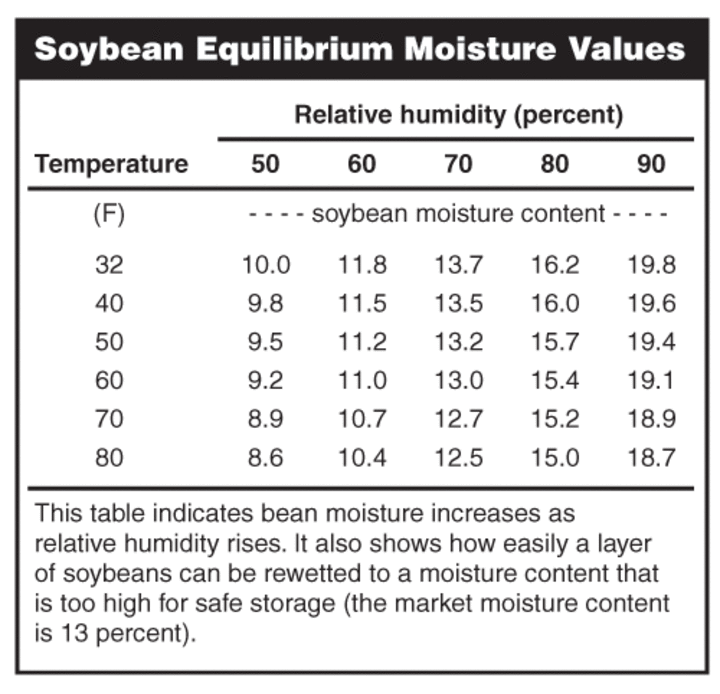Producers may want to condition soybeans that were harvested at lower moisture contents to bring the moisture content up to the market standard of 13%. On a 40-bushel-per-acre yield, harvesting soybeans at 9% moisture content, rather than 13%, is equal to 1.8 bushels of lost weight per acre. At $13 per bushel, that is $0.59 per bushel or $23.40 per acre. In addition, soybeans become more brittle, increasing the potential for handling damage when they are too dry.
However, conditioning low-moisture soybeans in storage can damage the grain bin. Conditioning causes the beans to expand, which can damage the grain bin’s bolted connections or even cause the bin to rupture from the increased pressure on the bin wall. The forces on the bin increase more rapidly than by the percentage of moisture content increase. Therefore, a moisture content increase of more than a couple points can be problematic and strategies to minimize the increased pressure should be practiced. The bin warranty may be voided if damage occurs while conditioning grain.
Just as grain is dried with bin fans, soybeans can be conditioned by operating fans during periods with the desired air temperature and relative humidity. Conditioning requires high airflow rates for several weeks using air with an average relative humidity of about 70-75% to condition soybeans to 13% during normal fall temperatures of 30-60°F. Be aware that the air will be heated three to five degrees as it goes through the fan, which reduces the air relative humidity slightly.
A conditioning zone develops and moves slowly through the bin in the direction of the airflow, which is similar to a drying zone in natural-air drying. Conditioning occurs the fastest when the airflow rate, cubic feet of airflow per minute per bushel (cfm/bu), is high and the air is warm and humid. The moisture holding capacity of the air is related to the temperature. At temperatures below about 40 degrees, the air holds very little humidity and little conditioning occurs. It will be the most successful in a drying bin with a fully perforated floor and a fan that can deliver at least 0.75 cfm/bu. Even with this airflow, moving a conditioning front all the way through the bin will probably take at least a month of fan operation. In most cases, not enough high-humidity hours are available in the fall to move a rewetting zone all the way through the bin. The conditioning can continue in the spring when outside temperatures average above about 40 degrees. You would need only a 3 hp fan to provide an aeration airflow rate of about 0.25 cfm/bu., but conditioning the beans would take about 90 days at that airflow rate.

Producers need to compare the cost of fan operation with the benefit of marketing at the desired moisture content. To estimate the cost of operating the fan, assume a one horsepower fan motor will use one kilowatt (kW) of electricity for each hour of operation. For example, if conditioning the soybeans takes 30 days of fan operation, that is 720 hours. Achieving an airflow rate of 0.75 cfm/bu on a 42-foot-diameter bin filled 20 feet deep with soybeans would require a 15-horsepower fan. The cost to operate the fan, assuming an electricity cost of 12 cents per kilowatt-hour is about $1,296 (720 hours x 1 kWh/hp x 15 hp x $0.12 kWh). Increasing the moisture content of 22,167 bushels of soybeans from 9-13% would increase the quantity of soybeans by 4.4% or 975 bushels. At a price of $13 per bushel, this is worth $12,675, which is more than the cost of operating the fan in this example.
If the fan is operated just in periods of very high humidity, such as during fog or when the relative humidity is near 100%, the soybeans in part of the bin would be too wet to be stored safely, about 20% or more. Mixing the wet layers with dry layers would reduce the spoilage risk and discounts for marketing wet beans. However, stirring increases the bean damage. Emptying the bin and moving the beans through a grain-handling system will provide only limited mixing because the majority of the grain comes from the top of the bin in a funnel shape with a center unloading sump.
Controlling the fan manually or on a time clock and operating it during the night and a portion of the day, based on the measured humidity, is one option, but fan and moisture control is not as accurate with this method.
A humidistat can operate the fan when the relative humidity will average about 70%. Even though the humidity level varies considerably during the day, it will average about 70% if the fan is operated for a time when the humidity is 90% and for an equal time when it is 50%. Setting the humidistat to operate the fan when the humidity exceeds about 60% would be a reasonable starting point. However, the humidity setting would need to be adjusted based on a measured soybean moisture content.
To avoid wetting the beans to moisture levels unsafe for storage, add a second humidistat to stop the fan when the relative humidity reaches very high levels, over 90%, or use a microprocessor-based fan controller that monitors temperature and humidity, and runs the fan only when air conditions will bring the crop to the desired moisture content. A disadvantage of these options is that the fan does not run as many hours.
Soybeans expand when they absorb moisture, so a moisture content increase of more than a couple points could create enough pressure to damage the grain bin’s bolted connections or even cause the bin to rupture. One way to reduce the pressure is to unload some beans from the bin periodically, maybe three times, during the conditioning. Another way to reduce the damage potential is to use a negative pressure system to pull humid air down through the soybeans and remove the soybeans from the top of the bin as they are reconditioned. An additional way to reduce the pressure is to use a vertical-stirring auger to mix the beans periodically. Stirring the beans will increase the amount of broken or damaged beans. Unfortunately, these methods of reducing pressure have not been well researched and are based on field experience primarily with smaller bins.
For more information about reconditioning, drying, handling and storing soybeans, see the Grain Storage Management section of CropWatch, the NDSU Extension soybean production guide and NDSU’s grain drying and storage website.

